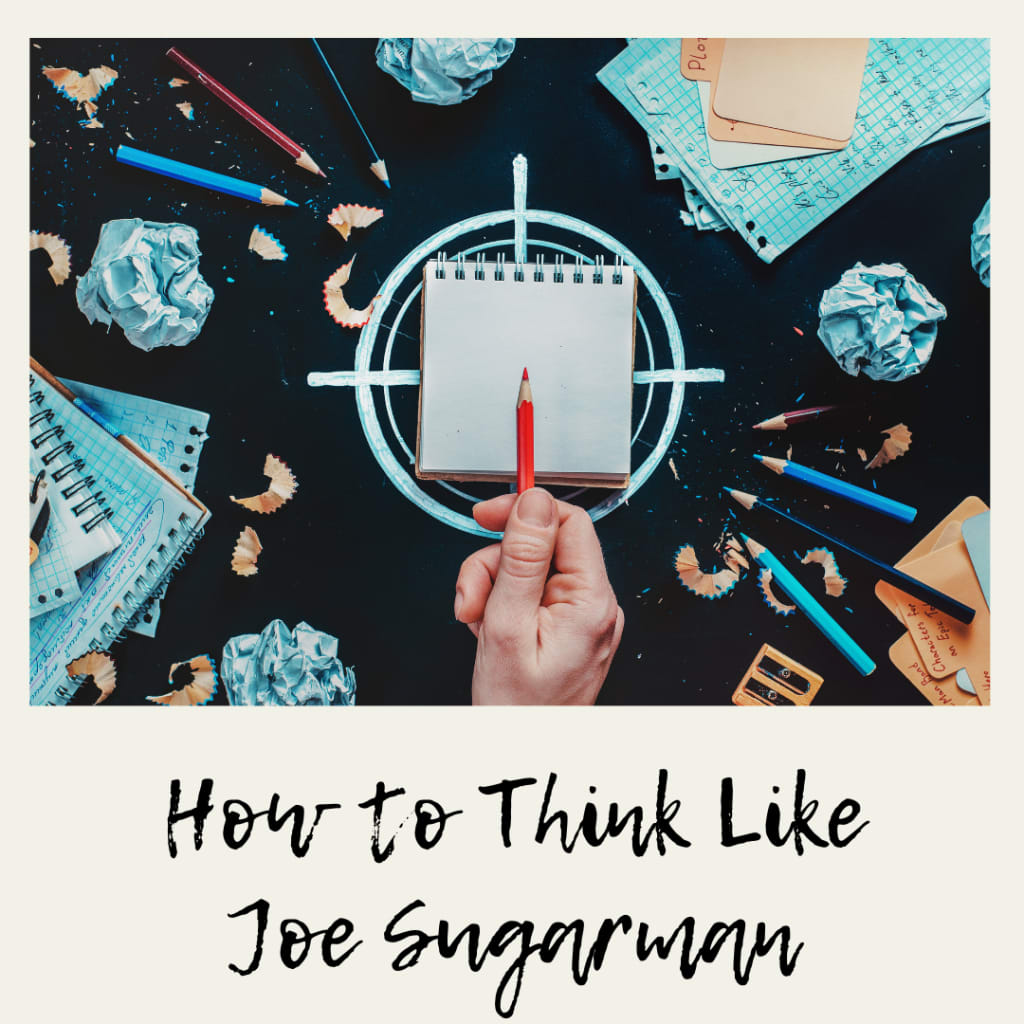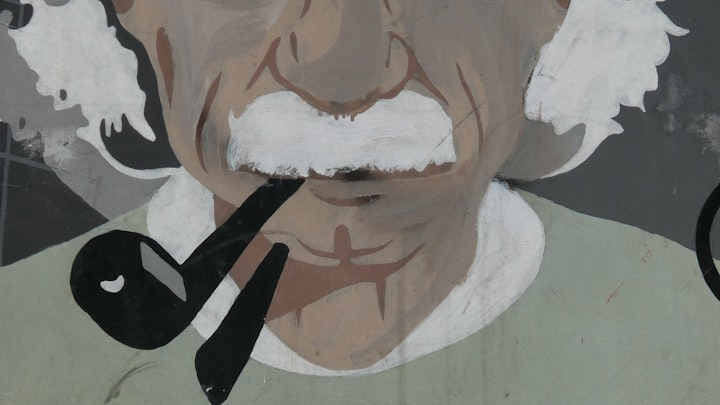How To Think Like Joe Sugarman
Make copywriting a lifestyle

If you’re in marketing, you know the name Joe Sugarman. If you don’t, shut this down, go buy his book and take the week or weekend off, I’ll be here when you come back and we can move forward then.
Seriously, if you want to understand great copywriting, take time studying what Joe Sugarman writes about it, and what he did to take it to new heights. He is a legend in copywriting for a reason, and there is so much to learn from him — both directly from his writing on the subject and from his example.
And that’s what we’re going to dive into today. We’re going to attempt to do a little mind-reading across time and space, taking a peek under the hood (so to speak) of what it means to think and act like a great copywriter.
Ready to dive in? Let’s go…
The copywriting lifestyle
What does it mean when you make something your lifestyle? It means that all the different parts of your life hum with that thing. Maybe in big ways at times, and maybe in small ways at other times, but whether in the foreground or the background, that thing that you’re making a lifestyle is always humming along.

You fuse your life with what you choose to build your life around. Hit pause for a second and soak that up. What you choose to build your life around is what you are fusing your life with. And if you’re doing that with copywriting, what this means is that you’re investing your time, energy, and effort into becoming a better and better copywriter every single day.
It means you’re studying the resources on the subject, you’re reading the books, you’re searching YouTube for great videos (I recommend the channel Copywriting Course by Neville Medhora ).
“The best copywriters in the world are those who are curious about life, read a great deal, have many hobbies, like to travel, have a variety of interests, often master many skills, get bored and then look for other skills to master. They hunger for experience and knowledge and find other people interesting. They are very good listeners.” — Joseph Sugarman, The Adweek Copywriting Handbook
You also build a lifestyle by being and staying curious. Curiosity is the cornerstone of knowledge and wisdom. The more curious you are, the hungrier you will be to learn, to read those books, watch those videos, listen to podcasts, buy courses, and practice the things you’re wanting to learn and build into your life.
But don’t stop with curiosity or knowledge. Knowledge is only as powerful as its usage. If you don’t use what you learn, you waste it, and over time, you just might lose it. This brings us to the next topic, failure. Don’t let a fear of failure hold you back, because truth is, there is no greater teacher than failing with purpose.
Failing forward
It’s never easy to try something and fail. It always stings, and it’s never particularly fun. But, failure is a powerful tool in creativity, copywriting, and life. You just have to learn how to look at, live with, and learn from failure in new ways.
“But more significantly, it is important to experience as much in life as possible and not to fear failure. It’s not whether you win or lose in life that’s important but whether you play the game.” — Joseph Sugarman, The Adweek Copywriting Handbook
Let’s apply this to copywriting. Great copywriting, like any writing, and any other endeavor for that matter, requires more practice than you care to think about. If that scares you off, then I just saved you a lot of time and wasted energy, but if you read something like that and decide it’s still worth it and you want to push forward, props, you’re now ready to go out there and fail your way to success.
“Lose enough and eventually you will win — it’s only a matter of time.” — Joseph Sugarman, The Adweek Copywriting Handbook
Now, roll up your sleeves, and get your fingers to typing. You will type some really ugly copy for an unbearably long time. Some days you will hit a wall, not know what the heck to write about, and other days you will stumble on some real gems.
But more often than not, you will try things, they won’t work, and no matter what you do about it, nothing will come together from it. You will try other things and those things will turn into tiny catastrophes and maybe even embarrass you. You will, in so many other words, fail and fail, and fail. And even after all that, you will fail again.
But there’s good news to all this failure: it can and should feed your fire.
Don’t overcomplicate it and just write the first draft
A couple of simple truths I live by as a writer (of copywriting and content) is that you simply can’t edit a blank page, and your first draft is always going to be ugly. There are no two ways around it, that first draft is going to be a lot different than your final one, and that’s all part of it.
Here’s the deal, your first draft isn’t meant for your audience. Not yet. The first draft is meant for you to figure out what the heck you’re saying, how you’re saying it, and how to say it better. Got that? Hit pause for a moment and let that really sink in.
Your first draft isn’t meant for your audience, it’s meant to help you get to a draft that is.
“I often pointed out to my students that if everybody in the class were given the assignment of writing a draft of an ad for a product, the first draft of my ad would quite likely be terrible compared to everybody else’s. It is what I do with the copy after my first draft that really makes the difference.” — Joseph Sugarman, The Adweek Copywriting Handbook
Now, let’s get into the weeds with this. Here’s another reality to let sink in: All too often we overcomplicate things when what we really ought to be doing is looking for ways to simplify them.
Copywriting might sound like a big scary word. It’s strange, it’s different and it has a whole set of unique goals that it’s after. Goals that content writing isn’t after. So, that can feel intimidating and maybe even a bit scary to try and come up with something for, right? But the thing is, that’s just you overcomplicating it.
“Copywriting is simply a written form of communicating facts and emotions. It is a mental process. Some copywriters will tell you that many of their greatest works were well thought out in their minds even before they put them on paper.” — Joseph Sugarman, The Adweek Copywriting Handbook
Copywriting is just writing with a specific purpose in mind. You use different tools to get there, tricks of the trade, psychology, formulas, and all of that, but at the end of the day, it’s still just writing. Keep it simple and you keep it fresh.
When you’re writing, write the first draft first and embrace the realities of what that first draft represents and asks of you. It’s asking you to simply put something on the page and then as you work your way through the next so many drafts, refine those words, tinker with its formatting and its visual look and feel (white spaces, paragraph length, sentence structure, tone of voice and all those fancy things).
But before anything else, don’t overcomplicate it, keep it simple and just get some words down. The rest will come after, but until you have those words on the page, you don’t have anything to work with. Give yourself something to work with first.
Being an idea person
What’s it mean to be an idea person? It means learning to take ideas that look, feel, and in so many ways are complete opposites or seem like there’s no way in the world they can work together — and find the one way they can. If you do this enough, make it a habit, practice it every day and then learn to apply this power to solving problems, damn, you just bossed up to a level few people ever do.
“Probably one of the most important keys in copywriting and conceptualizing is the ability to relate totally divergent concepts to create a new concept.” — Joseph Sugarman, The Adweek Copywriting Handbook
The world is overflowing with ideas, hell, the world is made from ideas. It’s amazing when you stop to think about it, but we essentially smash atoms around in a billion different ways to bring ideas to life, and we do it so casually and so easily, every hour of every day.
Your whole life, you’ve been processing experiences. Maybe you aren’t always aware of it, and maybe you haven’t slowed down long enough to think about it like this before, but that’s what’s going on. Touched something hot as a kid and burned your finger just enough, guess what, that’s an experience and it taught you not to do that again.
Fast forward to copywriting, how do you apply this reality? Everything you love and learn from, everything you’re hungry to learn about, all the road trips, adventures, and things you spend money on, they’re all your experiences and your teachers. Copywriters have to be a multi-tool set, not just a hammer looking for nails. You have to store up these experiences, learn from them, and above all, spend time with them.

There is nothing new in the world, just new ways of seeing problems, and from that, new ways to solve those problems. That’s the trick, that’s the goal. Learn to see problems in new ways, that’s what will set you apart and what will set you up for incredible success.
Shift your perspective, listen to your experiences, smash ideas together and see what happens. Take time out to just think, hit pause, and listen to your collection of experiences, ideas, and past lessons. What’s it saying to you? See where it fits in your current situation and tinker with your copywriting in new ways. Do this often enough and you will become an idea person.
Now we come to the nuts and bolts of copywriting itself
Remember, copywriting is about persuasion, and you’re persuading your audience to take a specific action — to buy, sign up for something, or be open to making a purchase later, and so on. So, without writing a small book here, how do you do that?
The simplest answer is that you keep your audience in mind. You study your experiences, look for connections between that experience and those you think might be interested in the thing you’re offering and writing copy for, and then you look for clues for how to connect those two realities from the product itself.
“Realize how important it is to know your product and know your customer. It is this specific knowledge that will make a dramatic difference in your ability to communicate your thoughts in copy.” — Joseph Sugarman, The Adweek Copywriting Handbook
If you don’t have a clue about the potential customer of the thing you’re copywriting for, you’re going to have weak copywriting at best. At worst, and honestly more than likely the reality, you’re going to have a real mess on your hands and another lesson dressed up as a little bit of failure.
But don’t let that scare you. It’s a simple fix (easier than fixing a flat tire!) just take time to know your product, and take time to know who might be interested in it and what problems they’re trying to solve that your product can help them with.
“In short, the product has a nature of its own and it’s up to you to discover what the nature of that product is in the mind of the consumer.” — Joseph Sugarman, The Adweek Copywriting Handbook
All good writing (and this is especially true of copywriting), hinges on how well you pay attention to your audience. The difference with copywriting is that you also have to pay attention to your product and how you connect it to your audience.
Take plenty of time out in your copywriting effort to simply pay attention to your potential customer. Listen to them, know what they want, what problems they’re facing, what they’re scared of, and what they hope for. Often times the clues you’re looking for in others are found first in yourself.
Once you get that down, take as much time or more with the product. Ask questions of it, study it out, know it, and know what it can do — even the stuff it wasn’t designed for but can be used for.
The more you know, the more you feed that big computer in your skull, and the more you have there, the more potential you have to find connections between things and come up with new spins on tired and worn-out old ideas. That’s where the magic happens.
The lesson here? Listen. Listen to the potential customer, and listen to the product.
Wrapping things up
So, there you have it. You’ve tapped into one of the greatest minds in copywriting, peeled back some of the layers of complication and mystery, and learned a few things along the way. Now comes the exciting part, putting it all into practice.
- Remember, great copywriting comes down to:
- Make it a lifestyle
- Fail forward
- Don’t overcomplicate it and just write the first draft
- Be an idea person
- Connect to the nature of the product
The only way to become a great copywriter yourself is to study others who have gone before you, look to their example, and above all, never let your knowledge sit idle.
When you learn something, apply it, practice it, and yes, fail at it until you find that first tiny win. Then double down and keep trying to build on that tiny win and each win after. It’s just that simple, and that danged hard.
About the Creator
Gregory D. Welch
Kentucky poet & scribbler. Inspiring creatives to live a creative lifestyle. Creating with courage, passion, & purpose-fueled growth. Progress over perfection.






Comments
There are no comments for this story
Be the first to respond and start the conversation.